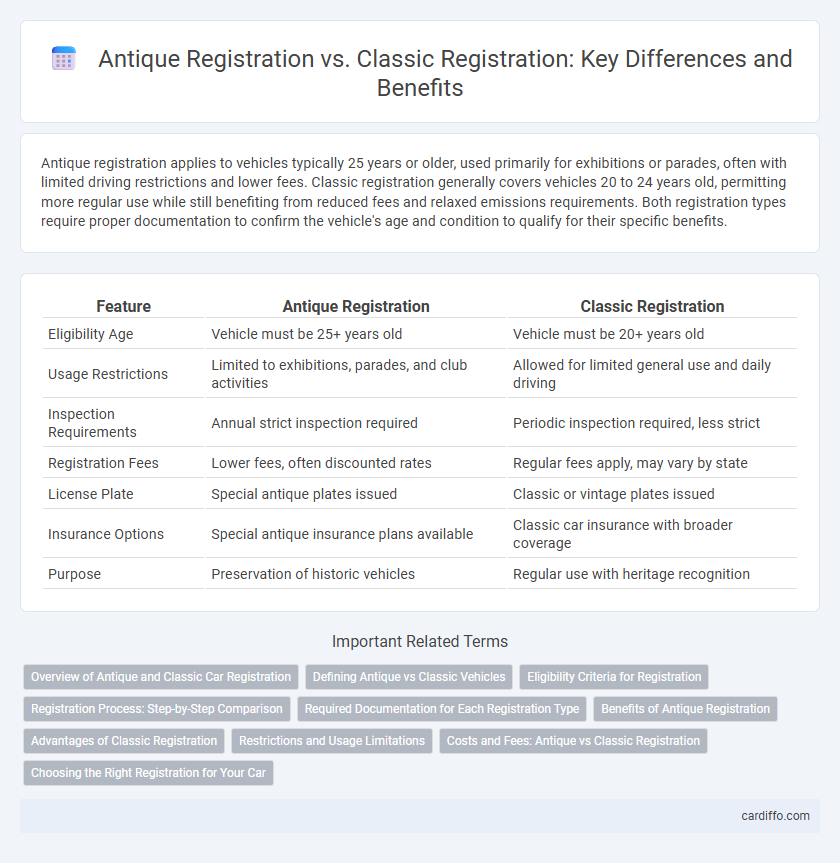Antique registration applies to vehicles typically 25 years or older, used primarily for exhibitions or parades, often with limited driving restrictions and lower fees. Classic registration generally covers vehicles 20 to 24 years old, permitting more regular use while still benefiting from reduced fees and relaxed emissions requirements. Both registration types require proper documentation to confirm the vehicle's age and condition to qualify for their specific benefits.
Table of Comparison
| Feature | Antique Registration | Classic Registration |
|---|---|---|
| Eligibility Age | Vehicle must be 25+ years old | Vehicle must be 20+ years old |
| Usage Restrictions | Limited to exhibitions, parades, and club activities | Allowed for limited general use and daily driving |
| Inspection Requirements | Annual strict inspection required | Periodic inspection required, less strict |
| Registration Fees | Lower fees, often discounted rates | Regular fees apply, may vary by state |
| License Plate | Special antique plates issued | Classic or vintage plates issued |
| Insurance Options | Special antique insurance plans available | Classic car insurance with broader coverage |
| Purpose | Preservation of historic vehicles | Regular use with heritage recognition |
Overview of Antique and Classic Car Registration
Antique car registration applies to vehicles typically 25 years or older that are preserved primarily for historical interest and not daily use, offering benefits such as reduced registration fees and limited usage restrictions. Classic car registration usually covers vehicles aged 20 to 40 years with original or restored condition, providing specialized plates and insurance options tailored for occasional driving and car shows. Both registration types emphasize preserving automotive heritage while allowing owners to enjoy unique privileges distinct from regular vehicle registration.
Defining Antique vs Classic Vehicles
Antique vehicle registration typically applies to cars that are 25 years or older and maintained in a condition close to their original manufacturer specifications, emphasizing historical preservation. Classic vehicle registration often covers cars aged between 20 and 40 years that may include some restoration or modifications reflecting cultural or stylistic significance. Understanding the differences between antique and classic vehicle definitions is crucial for owners to comply with specific legal requirements, insurance classifications, and benefits tied to each registration category.
Eligibility Criteria for Registration
Antique registration requires vehicles to be at least 25 years old and maintained in original or historically accurate condition, emphasizing preservation of automotive heritage. Classic registration typically applies to vehicles aged between 15 and 25 years, allowing limited modifications while maintaining the vehicle's vintage character. Eligibility criteria for both registrations often include proof of continuous ownership, valid insurance, and adherence to specific use restrictions set by regional transportation authorities.
Registration Process: Step-by-Step Comparison
Antique registration typically requires proof that the vehicle is over 45 years old and original or restored to its original specifications, with a simpler process involving documentation of age and condition to qualify for antique status. Classic registration often demands detailed vehicle history, proof of regular maintenance, and may involve stricter inspections to ensure the vehicle meets specific criteria for classic classification, such as age between 20 to 44 years. Both registrations require submitting applications to the DMV, but antique registration usually involves fewer steps and less frequent renewals compared to the more comprehensive verification and documentation process of classic registration.
Required Documentation for Each Registration Type
Antique registration requires proof of the vehicle's age, typically a certificate of manufacture or a historical verification document, along with the current title and a completed application form. Classic registration demands a combination of ownership history, valid insurance, and a completed vehicle inspection report, which demonstrates roadworthiness and originality. Both registration types often necessitate payment of specific fees and submission of identification to confirm eligibility under state regulations.
Benefits of Antique Registration
Antique registration offers exclusive benefits such as lower registration fees, exemption from certain emissions and safety inspections, and increased vehicle value through official recognition of its historic status. This classification allows owners to participate in vintage car shows and parades, providing opportunities for community engagement and preservation of automotive heritage. Unlike classic registration, antique status often grants broader legal privileges and insurance discounts tailored specifically to vehicles over a certain age, typically 25 years or older.
Advantages of Classic Registration
Classic registration offers extended coverage beyond the typical age requirement for antique vehicles, allowing owners of cars as young as 15 to qualify. It often provides better insurance rates compared to standard registration due to the vehicle's limited use and maintained condition. Owners benefit from increased flexibility for restoration and usage while preserving the vehicle's historical value.
Restrictions and Usage Limitations
Antique registration typically restricts vehicle usage to limited events such as parades, exhibitions, and club activities, prohibiting daily driving and commercial use. Classic registration allows more flexible use but may impose mileage limits and excludes usage for hire or freight transport. Both registrations enforce restrictions to preserve vehicle condition and authenticity while limiting wear and tear associated with regular use.
Costs and Fees: Antique vs Classic Registration
Antique vehicle registration typically incurs lower fees compared to classic registration due to its limited use and historical status, often qualifying for discounted rates or exemptions. Classic registration may involve higher costs reflecting broader usage permissions and additional inspections or documentation requirements. Understanding these cost differences helps owners select the most cost-effective and appropriate registration category for their vintage vehicles.
Choosing the Right Registration for Your Car
Antique registration typically applies to vehicles over 25 years old that are maintained mostly for exhibitions and parades, offering lower fees and limited use restrictions. Classic registration, usually for cars between 20 and 40 years old, allows more flexible usage but may involve higher costs and stricter maintenance standards. Evaluating your vehicle's age, intended use, and local DMV regulations ensures you select the appropriate registration category for optimal benefits.
Antique registration vs Classic registration Infographic

 cardiffo.com
cardiffo.com